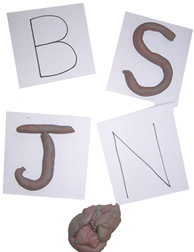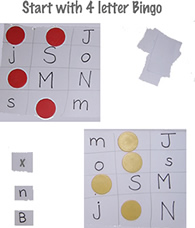The following eight activities help children remember letters and letter sounds and make teaching reading a more tactile, hands on experience.
Teaching reading with fun and simple hands on activities gives children practice with alphabet recognition, phonics, phonemic awareness, sight word recognition and word families.
Many children need more sensory involvement to remember their ABCs than workbooks and worksheets can provide.
Children can still be taught letters and to match the sounds with letters in a sequenced and direct way without the overuse of worksheets.
1. Teaching reading with modeling clay

Providing modeling clay or play dough type products helps children learn letters and letter sounds. Make six-inch square cards and print one large letter on each one. Children cover the letter lines with rolled modeling clay (great for fine motor skills too) .
2. Bring letter sound items for Show and Tell
Ask each child bring an item for Show and Tell that begins with a certain letter sound. Display the items, then work with the children to classify them into groups and count them. Example: Eight of the items that begin with “Mmm” are toys, three are books, etc… In what other ways could we sort them?
3. Teaching Reading with Sound “I Spy”
Have the children (or a small group of children) look for an object in the room that begins with the letter sound. When they find something they sit down and place it in the middle of the carpet. When all the children have returned with an object, slowly say the name of each one, emphasizing the beginning letter sounds.
An alternative easy word game focuses on rhyme.
- The teacher or a child might say, “I am thinking of a word that rhymes with c-a-t” and then draws a picture of it on a paper, without showing the other students.
- When the other children think of something that rhymes with cat, they draw it and/or try to spell the word on the whiteboard.
- When all the kids who want a turn have finished, the teacher or child, shows her picture.
- All count how many children thought of the same word
4. Play modified ABC Bingo
Play games like Bingo, but create your own cards to start with. Playing Bingo with 3 or 4 letters at a time is more beneficial than using a set with the whole alphabet on it.
Print the same letters on the cards two or three times so children have more than one opportunity to locate it. As children are able, use commercial ABC and word Bingo cards.
5. Paint letters
Paint letters at the easel using thick bright, colored paints and big brushes. Pin laminated letter cards to the top of the easels for children to copy.
6. Make letter shapes with your body
Print a very large letter, such as a capital “Y” on the chalkboard or whiteboard. Have the children put their feet close together and open their arms above their heads to make a “Y” shape. Say, “Let’s turn our “Y” into a ___”, as you change the letter on the chalkboard to a different letter.
7. Use Whiteboards
Using white boards seems to motivate kids to print and draw. I think children like the shiny way the pens glide over the boards and the ease of cleanup. They are available in easel form, as individual 8.5 x 11 boards and off course in many other sizes. Non-toxic pens are available for kids (and adults!)
8. Lego, pipe cleaners, wooden puzzles…
Use the same four to six-inch letter cards as you used for the modelling clay in #1 above and ask your students to create the ABCs with Lego, pipe cleaners or other touchy type materials. Wooden ABC puzzles are also helpful for many students.
